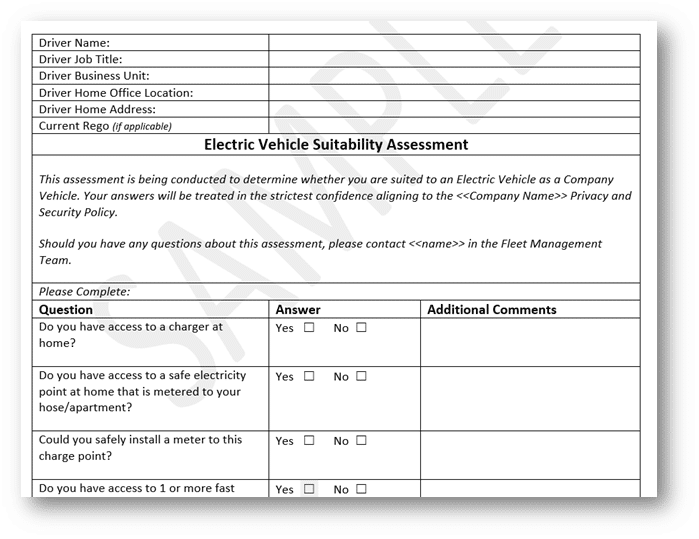
As the world shifts towards sustainable and lower emission modes of transportation, hybrid, and electric vehicles (EVs) are becoming an increasingly popular choice for individuals and businesses alike.
In Australia, EVs have gained popularity due to their environmental benefits, lower operational costs, and increasing corporate sustainability responsibilities. As a result, many organisations are now planning their transition to EVs as part of their short and long-term sustainability strategies. The shift to electric vehicles offers several advantages to organisations, including reduced carbon emissions, cost savings, regulatory compliance, and a positive public image.
While there are several positive outcomes while transitioning to an electric fleet, there are also many challenges that organisations face when trying to operationalise the transition.
First and foremost, the initial capital investment in EVs and charging infrastructure can be substantial, requiring careful financial planning. Additionally, range limitations and charging infrastructure availability can impact the operational flexibility of your organisation’s fleet, especially for long-distance or remote operations. Managing and educating employees about EV technology, including charging protocols and vehicle maintenance, is another change management consideration.
Also, for the first time in Fleet Management, we have had to consider an employee’s unique circumstances during a Fit for Purpose analysis, to determine whether they as an individual are suitable for an EV.
This is called a Driver Persona.

What is a Driver Persona
A Driver Persona is a detailed profile of an individual, outlining their suitability or preference for using an electric vehicle instead of traditional ICE (Internal Combustion Engines) vehicle. This persona considers various factors such as driving habits, business trip distances and profile, personal circumstances, access to charging infrastructure, and driver acceptance.
Driver Personas will help your organisation decide which drivers are suitable for an EV, and which drivers are not. These Personas are developed by completing a Driver EV Suitability Assessment and will uncover the driver’s personal circumstances relating to their charge options, trip personas and acceptance. The Driver EV Suitability assessment forms part of your overall Suitability Framework.
Understandably, this might be new territory for Fleet Managers with many unsure of the next logical step and how driver personas should be used in your overall fleet strategy. By taking a structured and pragmatic approach, you can demystify your electrification journey by taking some very simple steps.
Your electrification journey starts and ends with your Tool of Trade Policy

Step 1 – Review your policy
The transition to low emission vehicles can look complex, and hard to formalise using traditional fleet management methods that typically leave many questions unanswered. Not only are drivers faced with a steep learning curve, but Fleet Managers are also being asked questions for the first time, with little to no reference data for business cases that need to be developed.
Your Tool of Trade Policy, the document that must underpin your end-to-end fleet strategy, is the starting point in making a complex process, simple. By formalising your electrification strategy into your policy, organisations will be able to create the required framework for future decisions, with greater certainty around ensuring your drivers and your organisations trip requirements are being met.
Your Tool of Trade Policy will govern your suitability framework, which will form part of your overall fleet management framework, documenting and simplifying your organisation’s electrification journey.
Step 2 – Design your suitability framework
Driver Suitability Framework
A driver suitability framework forms part of your Tool of Trade Policy and evaluates whether an employee is well-suited to accept an EV as their company vehicle or are they a candidate for later EV adoption.
The framework typically involves analysing various factors, such as driving patterns, charging infrastructure availability, budget considerations, and driver acceptance to determine if transitioning to electric vehicles is a practical and cost-effective decision for your organisation.
This framework will help your organisation make an informed decision about whether EVs align with the specific needs and circumstances of your employees while also aligning to your broader fleet strategies.

Step 3 – Follow the eligibility process
To demystify how you get from eligible driver to which vehicle they should receive can be simple once you develop your foundations and follow the process.

Process 1 – Eligible driver
When an employee becomes eligible for a new or replacement company vehicle, they are sent the suitability assessment to complete. The assessment could include personal information disclosed by the driver, and as such appropriate information security processes should be followed to protect the privacy of this data.
Process 2 – Suitability assessment
The driver will then need to complete a suitability assessment to uncover their individual Driver Persona.

An example of a Suitability assessment, designed to uncover your driver’s suitability for an electric vehicle.
Process 3 – Internal review
Your fleet management team will then need to review the driver’s response and create their Driver Persona, which will help determine whether this driver is suited to a BEV (Battery Electric Vehicle) or ICE (Internal Combustion Engine) vehicle.
Process 4 – Suitability matrix
Once you have developed your Driver Persona, your fleet team will be able to overlay this to the driver’s trip data, and your organisation’s charging persona or policy. These data points, once consolidated and analysed, will provide you with the information that you need to input into a suitability matrix.
Your organisations suitability matrix will be unique, and will take into consideration your charging infrastructure position, your overall requirement for business travel and your eligibility matrix.

Example of an organisation’s Suitability Matrix.
Process 5 – Eligibility matrix
Once you have determined your driver’s eligibility, you should then use your eligibility matrix that is defined in your Tool of Trade Policy to allocate the appropriate vehicle according to their Driver Persona.
Your eligibility matrix should consider mobility rather than vehicle allocation as the determining factor for the allocation of company vehicles. Substitution remains a key component in fleet management and should be used where possible to ensure a well utilised fleet.
Step 4 – Reviewing your suitability framework
The EV market in Australia is expected to grow rapidly in the coming years and it is important to remember that your suitability matrix should be reviewed annually, aligning to your annual Tool of Tade Policy and eligibility matrix review.
Assessing market conditions, public charging availability and driver sentiment will be critical in ensuring that you are transitioning your fleet to electric vehicles at a rate that aligns to business readiness, sustainability targets and driver acceptance.
In the coming years we will see significant growth that will impact your suitability framework, including:
- More Affordable EVs: The cost of EVs is expected to continue to decline in the next two years, as battery technology improves, and economies of scale are achieved. This will make EVs more accessible to a wider range of organisations.
- More Diverse EV Models: The range of EV models available in Australia is expected to expand in the next two years. This will include more affordable options, as well as light commercial options.
- Improved Charging Infrastructure: The charging infrastructure for EVs is expected to continue to improve in the next two years. This will include the installation of more public chargers, as well as the development of faster and more convenient charging technologies.
- Increased Government Support: The Australian government is expected to continue to support EV adoption in the next two years. This could include the introduction of additional incentives, such as subsidies for the purchase of EVs or funding for charging infrastructure.
- Global Technology: Is moving at a rapid pace, with innovations to battery life expected in the coming years.
- Driver Acceptance: Will continue to change and evolve over time, with drivers becoming more accepting of the new technology as charging availability and industry continue to expand.
In summary, we all know that the transition to EVs will be gradual and will certainly pick up momentum in the years to come. By creating your fleet management framework, that includes a suitability framework with appropriate review routines, your organisation will enter the future of electrification with a solid foundation.
How can LBM Fleet help?
The LBM Advisory Team are currently working with organisations to help to develop their EV Transition, uncovering their Driver Personas and creating their unique suitability and eligibility framework, as well as reviewing Tool of Trade Policies to formalise their processes.
We also regularly talk about Australia’s journey towards electrification in our ongoing EV webinar series. In webinar two, we specifically covered how an organisation’s fit for purpose review has changed with the introduction of EVs including the extension into Driver Personas.
If you want to know more about Driver Personas and whether EVs are right for your team, get in contact with us today.

